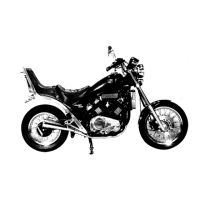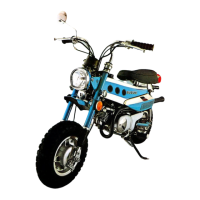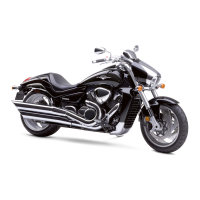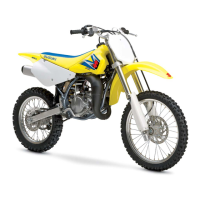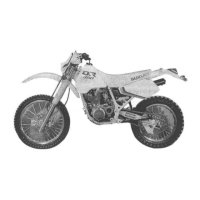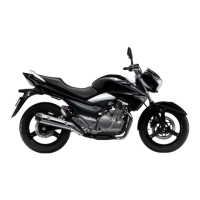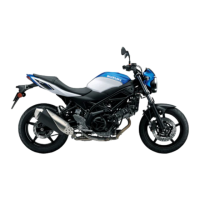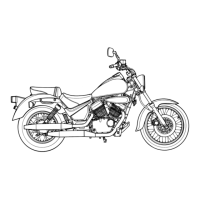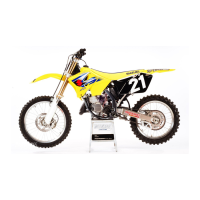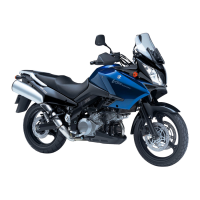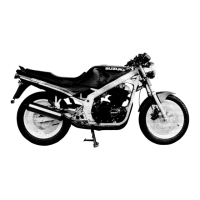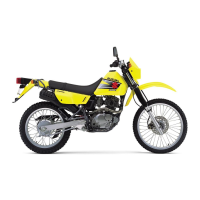Periodic Maintenance and Tune-Up Procedures Page: 13 Battery Procedures for inspecting and maintaining the motorcycle's battery.
Air Cleaner Instructions for cleaning and replacing the air cleaner element.
Spark Plug Information on cleaning and replacing spark plugs, including gap specifications.
Fuel Lines Inspection and replacement intervals for fuel lines.
Carburetor Adjusting idle RPM, throttle cable play, and choke cable.
Clutch Checking clutch fluid level and bleeding air from the clutch fluid circuit.
Cooling System Procedures for draining, flushing, and refilling the cooling system.
Brakes Checking front brake fluid level, brake pads, and bleeding air from the system.
Tires Checking tire tread condition, pressure, and replacement recommendations.
Steering Inspection and adjustment procedures for the steering system.
Front Fork Inspection and adjustment procedures for the front fork, including air pressure.
Engine Servicing Page: 30 Compression Check Procedure and specifications for checking engine cylinder compression.
Valve Face Wear Inspecting valve faces for wear and measuring the thickness service limit.
Valve Springs Checking valve spring free length and tension, and replacement criteria.
Camshaft Checking camshafts for wear on cams and journals.
Cam Wear Measuring cam height to check for wear and replacement criteria.
Cylinder Bore Measuring cylinder bore diameter and specifications for overhaul.
Piston Diameter Measuring piston outside diameter and checking for oversize options.
Starter Pinion Inspecting the starter pinion gear for smooth operation.
Oil Pump Warning regarding oil pump case securing screws and available replacement units.
Engine Reassembly Procedures for reassembling the engine, with notes on applying oil and installing parts.
Camshaft Timing Procedure for setting camshaft timing for the front cylinders.
Front Cylinder Detailed steps for timing the camshafts for the front cylinders.
Rear Cylinder Steps for timing the camshafts for the rear cylinders.
Shaft Drive Page: 115 Inspection Inspecting removed parts for damage or wear in the secondary bevel gears.
Reassembly Reassembling the secondary bevel gears, paying attention to specific points.
Backlash Installing secondary drive and driven bevel gears and tightening bolts.
Tooth Contact Checking tooth contact pattern after backlash adjustment using dye or paste.
Drive Bevel Gear Procedures for removing 0-rings, shims, oil seals, and couplings from the drive bevel gear.
Backlash Measuring and adjusting backlash for the final gear.
Tooth Contact Checking tooth contact pattern of final bevel gears and adjusting shims if necessary.
Cooling System Page: 153 Cooling System Overview of the engine cooling system, including components like pump, radiator, and thermostat.
Cooling Solution Guidelines for coolant mixture ratio, freezing points, and boiling points.
Inspection Testing the cooling system for tightness using a radiator tester.
Thermostat Steps to remove the thermostat and its cover, and test its operation.
Water Pump Procedures for removing, disassembling, and inspecting the water pump.
Removal Steps for removing the water pump assembly.
Disassembly Procedure for removing the water pump impeller.
Reassembly Reassembling the water pump, including replacing O-rings and using a new gasket.
Fan Motor Testing the cooling fan drive motor current.
Fuel and Lubrication System Page: 169 Fuel System Description of the fuel system components and their operation.
Fuel Cock Description of the fuel cock lever positions and their functions.
Fuel Pump Testing fuel pump resistance and discharge amount.
Fuel Pump Relay Measuring resistance between lead wires to check fuel pump relay condition.
Carburetor Carburetor construction, specifications, and adjustment procedures.
Slow System Description of the fuel supply system during low-speed engine operation.
Main System Description of fuel metering by main jet and needle jet during normal operation.
Starter System Explanation of how the choke lever and starter jet draw fuel for starting.
Float System Description of the float and needle valve mechanism maintaining fuel level.
Disassembly Cautions and steps for disassembling the carburetor assembly.
Reassembly Reassembling the carburetor, aligning needle jet groove, and installing float chamber.
Balancing Carburetors Procedure for calibrating and balancing the four carburetors using a balancer gauge.
Oil Pressure Checking engine oil level and oil pressure specifications.
Oil Sump Filter Instructions for washing and installing the oil sump filter.
Electrical System Page: 200 Charging System Procedures for checking charging output and AC generator no-load performance.
Ignition System Description of the transistorized ignition system components.
Ignition Coils Testing ignition coils for sparking performance using an electro tester.
Starter System Description of the starter system components and operation.
Oil Seal Checking oil seal lip for damage or leakage.
Water Temperature Meter Explanation of how the water temperature gauge works based on coil resistance and magnetic fields.
Lamps Wattage specifications for various motorcycle lamps.
Switches Inspect switches for continuity using a pocket tester.
Battery Specifications, initial charging, and servicing procedures for the battery.
Initial Charging Procedure for filling electrolyte and initial charging of a new battery.
Servicing Visual inspection of the battery container and cleaning of terminals.
Chassis Page: 224 Front Wheel Construction and disassembly procedures for the front wheel.
Wheel Bearing Procedures for driving out and removing wheel bearings using special tools.
Wheel Bearings Inspecting wheel bearings for play, noise, and smooth rotation.
Wheel Rim Checking wheel rim runout and adjusting spoke tension.
Tire Checking tire tread depth and wear limit.
Reassembly Reassembling the front wheel, including grease application and bearing installation.
Front Fork Removal procedures for the front fork assembly.
Disassembly Steps for disassembling the front fork, including removing valve cap and bleeding air.
Fork Spring Measuring the free length of the fork spring.
Reassembly Reassembling the front fork, including inner tube metal, oil lock piece, and damper rod bolt.
Fork Oil Specifications for front fork oil type and capacity, and adjusting oil level.
Inner Tube Installing the front fork assembly, aligning inner tube with steering stem bracket.
Steering Stem Construction and disassembly procedures for the steering stem.
Disassembly Steps for disassembling the steering stem, including removing front wheel, fork, and brake hose.
Handlebars Setting handlebars and securing clamp bolts to equalize clearance.
Brake Shoe Checking brake shoe wear indicator and replacing brake shoes if necessary.
Brake Drum Measuring brake drum I.D. for wear and inspecting for scratches.
Reassembly Reassembling the rear wheel, including wheel bearing installation.
Bearing Inspecting bearing play in rear shock, cushion lever, or rod.
Dust Seal Inspecting dust seals for damage and replacing if necessary.
Servicing Information Page: 270 Troubleshooting Guide for diagnosing and resolving engine, shaft drive, carburetor, and electrical issues.
Shaft Drive Troubleshooting guide for noisy shaft drive and oil leaks.
Carburetor Troubleshooting guide for carburetor issues like starting problems, idling, and fuel level fluctuations.
Radiator Troubleshooting for engine overheating or overcooling issues.
Electrical Troubleshooting guide for electrical system complaints like no sparking or poor charging.
Battery Troubleshooting for battery sulfation, leaks, and rapid discharge.
Chassis Troubleshooting for chassis-related issues like heavy handling, steering oscillation, and suspension problems.
Brakes Troubleshooting guide for front and rear brake issues like poor braking, squeaking, and fluid leakage.
Wiring Diagram Complete wiring diagram of the motorcycle's electrical system.
Brake Hose Routing Guidelines for correct routing of front brake hoses, including turning radius and avoiding twists.
Clutch Hose Routing Instructions for routing the clutch hose correctly, using guides and protectors.
Special Tools List of special tools required for servicing the motorcycle.
Tightening Torque Torque specifications for engine, shaft drive, and chassis components.
Service Data Standard and limit specifications for various engine, transmission, and chassis components.
Valve + Guide Standard and limit specifications for valve dimensions and clearances.
Clutch Specifications for clutch plate thickness, springs, and master cylinder components.
Carburetor Specifications for carburetor type, jets, and adjustments.
Electrical Specifications for ignition timing, spark plugs, coils, generator, starter, and battery.
Lamps Wattage specifications for various motorcycle lamps.
Brake + Wheel Specifications for brake components and wheel dimensions.
Suspension Specifications for front fork, rear wheel travel, and swingarm.
Tire Pressure Tire pressure specifications for solo and dual riding.
Vapor Hose Routing Diagrams showing the correct routing of vapor hoses for the emission control system.
